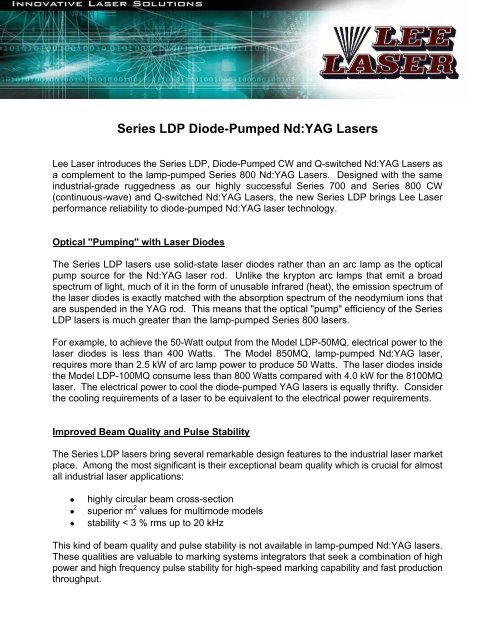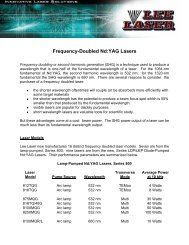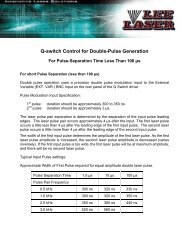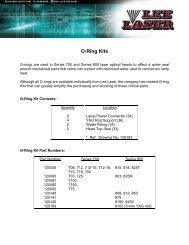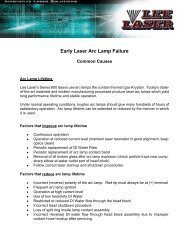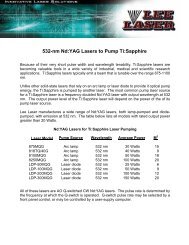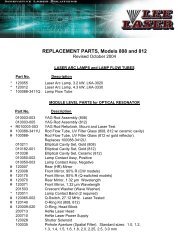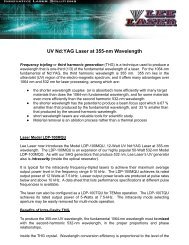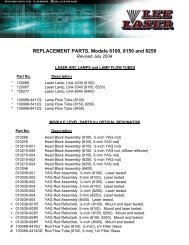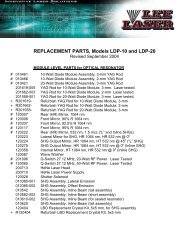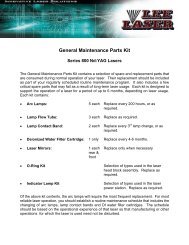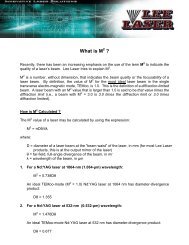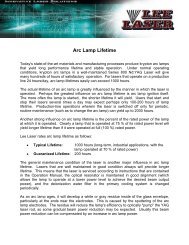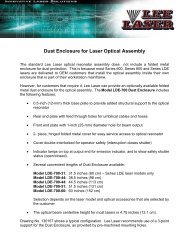Series LDP Diode-Pumped Nd:YAG Lasers - Lee Laser, Inc.
Series LDP Diode-Pumped Nd:YAG Lasers - Lee Laser, Inc.
Series LDP Diode-Pumped Nd:YAG Lasers - Lee Laser, Inc.
Create successful ePaper yourself
Turn your PDF publications into a flip-book with our unique Google optimized e-Paper software.
<strong>Series</strong> <strong>LDP</strong> <strong>Diode</strong>-<strong>Pumped</strong> <strong>Nd</strong>:<strong>YAG</strong> <strong><strong>Laser</strong>s</strong><br />
<strong>Lee</strong> <strong>Laser</strong> introduces the <strong>Series</strong> <strong>LDP</strong>, <strong>Diode</strong>-<strong>Pumped</strong> CW and Q-switched <strong>Nd</strong>:<strong>YAG</strong> <strong><strong>Laser</strong>s</strong> as<br />
a complement to the lamp-pumped <strong>Series</strong> 800 <strong>Nd</strong>:<strong>YAG</strong> <strong><strong>Laser</strong>s</strong>. Designed with the same<br />
industrial-grade ruggedness as our highly successful <strong>Series</strong> 700 and <strong>Series</strong> 800 CW<br />
(continuous-wave) and Q-switched <strong>Nd</strong>:<strong>YAG</strong> <strong><strong>Laser</strong>s</strong>, the new <strong>Series</strong> <strong>LDP</strong> brings <strong>Lee</strong> <strong>Laser</strong><br />
performance reliability to diode-pumped <strong>Nd</strong>:<strong>YAG</strong> laser technology.<br />
Optical "Pumping" with <strong>Laser</strong> <strong>Diode</strong>s<br />
The <strong>Series</strong> <strong>LDP</strong> lasers use solid-state laser diodes rather than an arc lamp as the optical<br />
pump source for the <strong>Nd</strong>:<strong>YAG</strong> laser rod. Unlike the krypton arc lamps that emit a broad<br />
spectrum of light, much of it in the form of unusable infrared (heat), the emission spectrum of<br />
the laser diodes is exactly matched with the absorption spectrum of the neodymium ions that<br />
are suspended in the <strong>YAG</strong> rod. This means that the optical "pump" efficiency of the <strong>Series</strong><br />
<strong>LDP</strong> lasers is much greater than the lamp-pumped <strong>Series</strong> 800 lasers.<br />
For example, to achieve the 50-Watt output from the Model <strong>LDP</strong>-50MQ, electrical power to the<br />
laser diodes is less than 400 Watts. The Model 850MQ, lamp-pumped <strong>Nd</strong>:<strong>YAG</strong> laser,<br />
requires more than 2.5 kW of arc lamp power to produce 50 Watts. The laser diodes inside<br />
the Model <strong>LDP</strong>-100MQ consume less than 800 Watts compared with 4.0 kW for the 8100MQ<br />
laser. The electrical power to cool the diode-pumped <strong>YAG</strong> lasers is equally thrifty. Consider<br />
the cooling requirements of a laser to be equivalent to the electrical power requirements.<br />
Improved Beam Quality and Pulse Stability<br />
The <strong>Series</strong> <strong>LDP</strong> lasers bring several remarkable design features to the industrial laser market<br />
place. Among the most significant is their exceptional beam quality which is crucial for almost<br />
all industrial laser applications:<br />
highly circular beam cross-section<br />
superior m 2 values for multimode models<br />
stability < 3 % rms up to 20 kHz<br />
This kind of beam quality and pulse stability is not available in lamp-pumped <strong>Nd</strong>:<strong>YAG</strong> lasers.<br />
These qualities are valuable to marking systems integrators that seek a combination of high<br />
power and high frequency pulse stability for high-speed marking capability and fast production<br />
throughput.
2<br />
Twenty-six <strong>Series</strong> <strong>LDP</strong> lasers are now available, eight of which are frequency doubled. Eight<br />
lasers are designed for TEMoo-mode operation.<br />
Model Wavelength Mode<br />
CW<br />
Power<br />
Q-switched<br />
Avg. Power*<br />
Beam<br />
Diameter<br />
Beam<br />
Divergence<br />
<strong>LDP</strong>-10T 1064 nm TEMoo 10 Watts .9 mm 2.0 mr<br />
<strong>LDP</strong>-10TQ 1064 nm TEMoo 10 Watts 6 Watts .9 mm 2.0 mr<br />
<strong>LDP</strong>-15T 1064 nm TEMoo 15 Watts 1.0 mm 2.0 mr<br />
<strong>LDP</strong>-15TQ 1064 nm TEMoo 15 Watts 12 Watts 1.0 mm 2.0 mr<br />
<strong>LDP</strong>-100TQ 1064 nm TEMoo 18 Watts 15 Watts 1.0 mm 1.6 mr<br />
<strong>LDP</strong>-20M 1064 nm Multi 20 Watts
3<br />
The standard length of the optical for the <strong>Series</strong> <strong>LDP</strong> lasers will be 40" (about 1 meter, options<br />
dependent), same as with the <strong>Series</strong> 800 lasers. Most laser micro-machining applications,<br />
such as marking, require a minimum pulse width for maximum effectiveness. If laser pulses<br />
are too short, then the machining process may actually become less efficient. Therefore, the<br />
length of the <strong>Series</strong> <strong>LDP</strong> optical resonators is much the same as with <strong>Series</strong> 800 lasers.<br />
However, the shorter head block will make it possible to reduce the length of the optical<br />
resonator if short pulse width performance is desired.<br />
<strong>Laser</strong> Cooling System<br />
Unlike other diode-pumped <strong>Nd</strong>:<strong>YAG</strong> lasers, the <strong>Lee</strong> <strong>Laser</strong> optical design for the <strong>Series</strong> <strong>LDP</strong><br />
lasers is insensitive to small fluctuations in cooling water temperature. The match of the laser<br />
diode emission spectra and neodymium ion absorption spectra can be maintained with<br />
temperature variations as great as 1.0 o C. Therefore, it is not necessary to utilize a highly<br />
precise, expensive and inefficient, refrigerated cooling system to maintain constant diode<br />
temperature.<br />
Instead, <strong>Lee</strong> <strong>Laser</strong> uses the same design of water/water cooling system that has proved to be<br />
so reliable for the company's popular <strong>Series</strong> 800 lamp-pumped <strong>Nd</strong>:<strong>YAG</strong> lasers. Smaller, of<br />
course, than the <strong>Series</strong> 800 cooling system, the <strong>Series</strong> <strong>LDP</strong> cooler is highly efficient, simple in<br />
design and inexpensive to manufacture.<br />
To remove heat from the laser, the user must provide a source of external cooling water, such<br />
as city water. The quantity of water is much smaller than what is required for lamp-pumped<br />
<strong>Nd</strong>:<strong>YAG</strong> lasers, only 2-60 l/min, maximum at 15 o C.<br />
For end users that are not able to provide an external source of cooling water, <strong>Lee</strong> <strong>Laser</strong><br />
offers an optional, fully self-contained chiller unit that is integrated into the laser's power<br />
station cabinet. Heat removed from the laser is vented into the room in which the power<br />
station is located. The optional chiller is available on all models with output power up to 200<br />
Watts at 1064-nm wavelength.<br />
Electrical Power Consumption<br />
The inherent efficiency of the <strong>LDP</strong> <strong>Series</strong> lasers means that much less electrical power is<br />
required to operate them. All laser models require 220-VAC, 1-phase input power, 50 or 60<br />
Hz. For most models, total power consumption does not exceed 2 kW (< 10 Amperes), even<br />
with a variety of options included with the laser (such as Q-switch, HeNe laser, internal<br />
refrigerated chiller, etc.). For the Models <strong>LDP</strong>-200MQ and <strong>LDP</strong>-200MQG, total electrical<br />
power consumption is < 3 kW (< 15 Amperes) with water/water heat exchanger.
4<br />
Frequency-Doubled Models<br />
The low-beam-divergence performance of the <strong>Series</strong> <strong>LDP</strong> lasers makes them ideal for<br />
efficient harmonic generation. Eight (8) frequency-doubled models have been configured, with<br />
Q-switched average output power up to 150 Watts at 532-nm wavelength.<br />
These lasers contain LBO (lithium borate) as the SHG crystal. LBO is the most durable SHG<br />
crystal that is commercially available, as much as seven (7) times more damage resistant than<br />
KTP. For best performance, LBO must be maintained at an elevated temperature. For this<br />
reason, the crystal is housed inside a temperature controlled oven.<br />
<strong>Laser</strong> <strong>Diode</strong> Lifetime<br />
Perhaps the greatest concern of all purchasers of the <strong>Series</strong> <strong>LDP</strong> lasers is the expected and<br />
guaranteed lifetimes of the laser diodes. <strong>Lee</strong> <strong>Laser</strong> has taken extraordinary measures to<br />
maximize diode lifetime, which is vital for cost justification and return on investment in the<br />
industrial laser marketplace, and to prolong diode replacement.<br />
The <strong>Series</strong> <strong>LDP</strong> lasers are characterized by the following design criteria:<br />
1. <strong>Laser</strong> diodes are rated by their manufacturers for operation up to 45-Amperes<br />
2. <strong>Lee</strong> <strong>Laser</strong> current limits the diode power supplies at maximum of 37-Amperes<br />
3. All <strong>Series</strong> <strong>LDP</strong> lasers typically achieve their rated output power level at a diode current<br />
level less than 28-Amperes<br />
Simply stated, unlike our competitors <strong>Lee</strong> <strong>Laser</strong> uses many more diodes in each <strong>Series</strong> <strong>LDP</strong><br />
laser than is needed to meet that laser's performance specifications. With more diodes to<br />
share the optical pumping load, the diodes are operated at a much reduced current level,<br />
which greatly extends diode lifetime.<br />
The expected lifetime of the laser diodes in <strong>Series</strong> <strong>LDP</strong> lasers is 10,000 to 20,000 hours.<br />
Since <strong>Lee</strong> <strong>Laser</strong> began delivery of the <strong>Series</strong> <strong>LDP</strong> lasers in June 1998, <strong>Lee</strong> <strong>Laser</strong> has<br />
delivered approximately 800 diode-pumped lasers with output power levels that range up to<br />
300 Watts at 1064 nm and 150 Watts at 532 nm. The diode modules of many of the earliest<br />
lasers now have been returned to <strong>Lee</strong> <strong>Laser</strong> for diode replacement. The recorded lifetimes<br />
from hour meters attached to the diode modules are averaging more than 20,000 hours.


